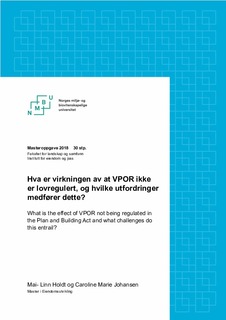| dc.contributor.advisor | Holth, Fredrik | |
| dc.contributor.author | Holdt, Mai-Linn | |
| dc.contributor.author | Johansen, Caroline Marie | |
| dc.coverage.spatial | Norway, Oslo | nb_NO |
| dc.date.accessioned | 2018-06-28T10:49:32Z | |
| dc.date.available | 2018-06-28T10:49:32Z | |
| dc.date.issued | 2018 | |
| dc.identifier.uri | http://hdl.handle.net/11250/2503557 | |
| dc.description.abstract | I 2007 brukte Oslo kommune for første gang verktøyet «Veiledende plan for offentlig rom (VPOR)», som en del av «Oslomodellen». VPOR er ikke forankret juridisk i plan- og bygningsloven, men legger likevel føringer for arealbruk tidlig i planprosessen. Denne masteroppgaven tar for seg noen utfordringer ved at Plan- og bygningsetaten i Oslo benytter seg av strategiske planer som VPOR.
Ved å studere deler av prosessen for arealplanlegging i Oslo kommune skal dette belyses ved å stille opp en problemstilling. For å danne et bilde av den betydning det har å bruke strategiske planer som VPOR har det blitt hentet inn informasjon, foretatt intervjuer og dokumentanalyser. Denne informasjonen er deretter vurdert opp mot relevant teori og rettspraksis.
Graden av fleksibilitet som ligger i arealplanleggingen er blitt utfordret i Oslo de seneste årene. En årsak er den raske byutviklingen (de Vibe, 2015). Denne analysen ser på hvordan Plan- og bygningsetaten har utviklet VPOR som et virkemiddel med større fleksibilitet for å håndtere den sterke byutviklingen på prosess-siden.
Gjennom analysen og drøftingen har flere temaer vært oppe for diskusjon. Noen av disse temaene er saksbehandlingsregler, kostnadsberegning og forhåndsbinding. Gjennom hele oppgaven vurderes spørsmålet om mangel på virkemiddel burde vært løftet opp som et lovgiver-spørsmål. Likevel ser vi nytten av at Plan- og bygningsetaten utfordrer dette rommet, ved å ha løst det på prosess-siden.
I tillegg drøfter oppgaven positive og negative sider ved eventuell lovfesting av VPOR i plan- og bygningsloven. Legitimitet, fleksibilitet, effektivitet og demokrati er hensyn og prinsipper som kan stå imot hverandre og som vurderes i oppgaven. Om VPOR bør bli lovfestet eller ikke, avhenger av hvordan den implementeres i Plan- og bygningsloven. Oppgaven gir eksempler på hvordan dette kan gjøres. | nb_NO |
| dc.description.abstract | In 2007, the municipality of Oslo introduced for the first time its «Veiledende plan for offentlige rom (VPOR)» as part of the so-called «Oslo model». VPOR is not legally connected to the Planning and Building Act, but still applies requirements for land use early in the planning process. This master thesis addresses some challenges in connection with the Oslo Planning and Building Agency’s use of strategic plans such as VPOR.
By studying parts of the area planning process in Oslo municipality, the issue is highlighted. In order to form a picture of the importance of using strategic plans such as VPOR, information has been gathered, interviews made and documents have been analysed. Our findings have been assessed against relevant theory and case law.
In recent years, the degree of flexibility in area planning in Oslo has been challenged. An important reason is the rapid urban development. The analysis looks at how the Planning and Building Agency has developed VPOR as a tool with greater flexibility to handle the process of strong urban development.
The Planning and Building Agency has solved the challenge of lack of tools on the process side. Through our analysis and discussion, it is considered if the lack of remedies should be a question for the legislator. Nevertheless, we see the benefit that the Planning and Building Agency challenges this space by solving it on the process side. Through the analysis and discussion, several topics have been discussed. Some of these are case processing rules, cost calculation and pre-binding. Throughout the study, the question is considered whether a lack of instrument should have been lifted as a legislator's question (at legislator level). Nevertheless, we see the benefit in the Planning and Building Agency challenging this shortcoming by solving it on the process stage.
In addition, the document discusses positive and negative aspects of possible statutory rights of VPOR in the National Planning and Building Act. Legitimacy, flexibility, efficiency and democracy are considerations and principles that can stand against each other and are therefore discussed. Whether VPOR should be statutory or not, depends on how it may be implemented in the Planning and Building Act. Our study gives examples of how this could be done. | nb_NO |
| dc.language.iso | nob | nb_NO |
| dc.publisher | Norwegian University of Life Sciences, Ås | nb_NO |
| dc.rights | Attribution-NonCommercial-NoDerivatives 4.0 Internasjonal | * |
| dc.rights.uri | http://creativecommons.org/licenses/by-nc-nd/4.0/deed.no | * |
| dc.title | Hva er virkningen av at VPRO ikke er lovregulert, og hvilke utfordringer medfører dette? | nb_NO |
| dc.title.alternative | What is the effect of VPOR not being regulated in the Plan and Building Act and what challenges do this entrail? | nb_NO |
| dc.type | Master thesis | nb_NO |
| dc.source.pagenumber | 125 | nb_NO |
| dc.description.localcode | M-EUTV | nb_NO |

